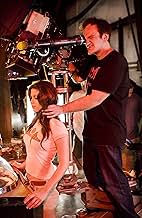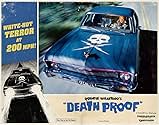Dos grupos de mujeres son acosados en diferentes momentos por un especialista con cicatrices que usa sus autos "a prueba de muerte" para ejecutar sus planes asesinos.Dos grupos de mujeres son acosados en diferentes momentos por un especialista con cicatrices que usa sus autos "a prueba de muerte" para ejecutar sus planes asesinos.Dos grupos de mujeres son acosados en diferentes momentos por un especialista con cicatrices que usa sus autos "a prueba de muerte" para ejecutar sus planes asesinos.
- Premios
- 8 nominaciones en total
- Jungle Julia
- (as Sydney Poitier)
- Dirección
- Guionista
- Todo el elenco y el equipo
- Producción, taquilla y más en IMDbPro
Opiniones destacadas
As this is intended to be Tarantino's answer to '60s and '70s B-movies, the plot of Death Proof is extremely simple: there is a psychopath, named Stuntman Mike (Kurt Russell), who enjoys killing women with his car, a virtually indestructible vehicle ("This car is 100% death proof. Only to get the benefit of it, honey, you REALLY need to be sitting in my seat!"). Whenever he arrives in a new town he selects a group of girls and sets his perverse plan into motion. And unless he runs into someone who is as crazy or drives as well as him, there is no way to stop him.
Those expecting QT's usual stream of film references will be disappointed: apart from a hilarious restaurant scene that sort of spoofs the opening of Reservoir Dogs and a couple of nods to similarly themed horror flicks (and, of course, the casting of Russell, which is a deliberate homage to John Carpenter), the director is not interested in exposing his absolute knowledge of this kind of cinema. This time, he delivers a straightforward genre movie, albeit with his trademark tough women at the center. The trailer promised a wildly fun B-movie, and that's exactly what Death Proof is: a movie like they don't make anymore, old-fashioned, irony-free and exciting as hell.
However, this does not mean Tarantino has set his visual or verbal obsessions aside: the dialogue is as imaginative and surreal as it has always been, and there are enough shots of bare female feet to keep fans happy. Naturally, being this a QT flick, those feet belong to a quality cast: the only real star in the film (apart from the villain, that is) is Rosario Dawson, but she is part of a talented ensemble, which includes Vanessa Ferlito (CSI: NY), Rose McGowan (Scream) and stunt-woman Zoe Bell (who doubled for Uma Thurman in Kill Bill). The mention of honor, though, goes to Russell, who finally has the opportunity to go all bad again, and boy, does he go bad: even when he is pretending to be a friendly chap who offers you a ride home, he exudes a sense of menace that doesn't leave until the end of the picture. Also worth praise are Michael Parks, reprising his role of foul-mouthed sheriff Earl McGraw (of From Dusk till Dawn and Kill Bill fame) and tying the two halves of the film together, and Tarantino himself, popping up as smug, ridiculously likable bartender Warren. The latter is particularly charming because, unlike other times (From Dusk's Richie Gekko is a good example), QT does not try to prove he can act (although he pulled off a remarkable job in Alias). He's just there for the sheer fun, like everyone else.
Pure, unadulterated fun and excitement: that's the key to appreciating Death Proof. Do not expect a smart, unusual take on an overused genre, like the director has done in the past: this time around, he sticks to the rules, delivering a loud, silly, sexy, violent piece of Entertainment with a capital "e". It may not be the best film of 2007, but it sure as hell is one of the most purely enjoyable.
Vanessa Ferlito as Arlene, who I would watch sitting in a chair for an hour anytime. It was well worth it to see that lap dance. Ferlito was clearly the star of this film.
Then there were the badass girls: Tracie Thoms as Kim and Rosario Dawson as Abernathy. I could watch them ride around in a car for an hour anytime.
It was the last third of the film where the action was ramped with some fantastic stunt work by badass Zoe Bell and, of course, the coup de grâce, Abernathy's boot in Stuntman Mike's (Kurt Russell) face. Heavenly.
It also sets out to pastiche the "grindhouse" cinema phenomena, with the original idea of two films being shown as a double feature at drive-in movie theatres from state to state, with both films often being re-cut and re-edited, not by the filmmakers, but by the theatre owners themselves. This is evident in the amusing switch in title; with the film opening with the caption 'Quentin Tarantino's Thunderbolt', before awkwardly cutting to an obviously out of place title card with 'Death Proof' crudely emblazoned across the screen. This is also the explanation for the purposeful mistakes in continuity, the sloppy editing and the switch between colour and black and white, as well as the façade of severely deteriorating film stock. It's not sloppy film-making, but rather, a purposeful appropriation of sloppy film-making geared towards appealing to the kind of obsessive movie aficionado who gets the references and can appreciate the joke that Tarantino is attempting to pull.
With this in mind, it seems hard to understand what people are complaining about. Do audiences actual expect this film to keep them enthralled and entertained when the vast majority of them would balk at experiencing many of the low-budget, semi-obscure films that influenced it? Hardly! The accusation here that "nothing happens" is fascicle. The fact that there is film running through the camera is proof enough that something is happening, with the hilariously bland dialog deconstructing the film in much the same way as the purposely amateurish composition, editing and sound all intended to fracture the cinematic language in the same way that Godard did; by reminding the audience that this is the film and the point of the film is to experience the sights and sounds that unfold before us. Added to this the colourful iconography, the music, the characters, the girls in tight t-shirts, the for once entirely justified performance from the man himself, all reminding us that this is a joyous, darkly comic romp in which the point is not "why?" but "why not?".
The effect is reminiscent of Kill Bill (2003), which at times felt superficial or perhaps even too knowing for its own good, but still demonstrated to us the filmmaker's great use of tone, texture, colour and movement, as well as turning many people on to a whole new world of cult Japanese cinema; from the works of highly individual filmmakers like Seijun Suzuki, Kinji Fukasaku and Takashi Miike, to cult performers like Sony Chiba. Death Proof attempts to do something similar with the likes of the American revisionist road movie, the B-cinema of Roger Corman and the femsploitation subgenre of films like The Big Bird Cage (1972), Caged Heat (1975), Day of the Woman (1978) and Ms. 45 (1981); a coolly ironic series of films in which wronged women take bloody revenge in an often elaborate and over the top style, chiefly intended to give a feminist slant to the still rampant degradation and misogyny prevalent in the exploitation genre.
Other reference points are more obvious as they're mentioned explicitly in the film; notably car chase cinema such as Vanishing Point (1971), Two-Lane Blacktop (1971), Dirty Mary, Crazy Larry (1974), Gone in 60 Seconds (1974) and even Spielberg's Duel (1971). Some have complained that the film fails on account of its lack of action and emphasis on dialog and technique, but this seems churlish when you think of the films being referenced; with Vanishing Point featuring a number of cryptic, desert-set sequences in which characters talk and talk and talk, while Two-Lane Blacktop punctuates its scenes of hard driving and drag-racing with much in the way of meandering small-talk. Then we have the fact that films like Reservoir Dogs - which takes place almost entirely within a single setting - and Jackie Brown - which places emphasis entirely on character - use dialog to not only create the characters but to also tell the story.
Regardless of this, Death Proof is meant as a piece of entertainment. There's no real desire here for Tarantino to prove what kind of filmmaker he is because he's already done that with the number of great films that came before. Sure, it can be seen as self-indulgent, but surely those of us familiar with the style of film-making being referenced here will revel in this particular kind of extravagance, loving everything from the continually inane female banter to the awesome scenes of high speed carnage. If you're not a fan cult cinema or exploitation cinema or indeed a devotee of Tarantino's work then this film really isn't going to impress you. There's no shame in that. Some films are made for a niche audience, destined to be a cult in their own right. However, for those who get it, Death Proof has the potential to be a truly exhilarating, one-off piece of film-making.
¿Sabías que…?
- TriviaAfter Zoë Bell was cast, Quentin Tarantino told Bell that he would hire a second stunt person to take Bell's place in the stunt scenes where her face wasn't visible. Bell insisted on performing every stunt herself, saying if someone else were cast in her role, and she was only performing the stunts, those were the stunts she would do. Tarantino honored her request.
- ErroresAs 'Death Proof' is an homage to the old, low-budget Grindhouse films of the 70's and 80's, there are many deliberate errors by the filmmaker to give an authentic Grindhouse feel.
- Citas
Stuntman Mike: [Stuntman Mike and Pam are in his death-proof car, but Pam is in the passenger-seat which is in a crash-box] Well, Pam... Which way you going, left or right?
Pam: [enthusiastic] Right!
Stuntman Mike: Oh, that's too bad...
[ominous sound effect]
Pam: Why?
Stuntman Mike: Because it was a 50-50 shot on whether you'd be going left or right. You see we're BOTH going left. You could have just as easily been going left, too. And if that was the case... It would have been a while before you started getting scared. But since you're going the other way, I'm afraid you're gonna have to start getting scared... immediately!
- Créditos curiososIn the OPENING credits during the prologue driving sequence, after "Kurt Russell in" there is a quick ten-frame color animation of the title "Quentin Tarantino's Thunder Bolt" which cuts immediately to a simple grainy white-on-black title screen that says "Death Proof".
- Versiones alternativasAfter Zoe flies off the hood, she walks back to the car and says, "Phew that was a close one". In the Unrated Extended version it then cuts right to her line, "So, where's the maniac?" In the U.S. Theatrical Double Feature version there's some extra lines of dialog in between: As Zoe notices that Abernathy and Kim have been crying she remarks, "You guys look like shit. Who died?" Abernathy then asks Zoe if she's okay, to which she replies, "Well, I'm gonna have a hell of a bruise on my bum, but aside from that I'll be sweet."
- ConexionesEdited from Grindhouse (2007)
Selecciones populares
Detalles
- Fecha de lanzamiento
- País de origen
- Idioma
- También se conoce como
- Death Proof
- Locaciones de filmación
- Productoras
- Ver más créditos de la compañía en IMDbPro
Taquilla
- Total a nivel mundial
- USD 31,126,421
- Tiempo de ejecución2 horas 7 minutos
- Color
- Mezcla de sonido
- Relación de aspecto
- 2.35 : 1
Contribuir a esta página









































